Local sewage for a country house
Wastewater is an integral part of human life. It is good if there is a centralized system for their removal, but not everywhere it is available. In this case, you need to learn how to design and install local sewage for a country house.
Calculations
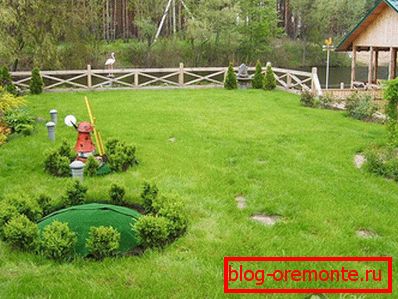
Before you begin any calculations, you must be well acquainted with your site. In advance it is important to obtain data on the level of groundwater occurrence, the amount of precipitation, etc. Also decide whether you will do everything on your own or hire specialists.
- We decide on the place where our future installation will be located. The distance to it should not be too large, nor should it be too close. For every centimeter of distance to the cesspool or septic tank, a pipe slope of 2 × 3 cm is required. If the length of the main is large, then the pit will need to be made deep enough to provide drainage. In the case when this type of sewage system is closer than 5 m to the foundation, the wastewater may go under the building, which will cause shrinkage and cracks in the base and walls. With such an arrangement, it will be especially necessary to approach the waterproofing of the entire structure. If you have a well or a well in the yard, then the receiver for the effluent will need to be removed at least 30 m from them. It is important that the pathogens do not enter clean water. Well, if there is an opportunity to make it closer to the passage, so that the trucker has a free entrance.
- There must be sufficient distance from lakes or rivers. The minimum distance is the same as for wells and wells.
- If you plan to place a mini-sewage treatment plant, will there be enough space to accommodate the outlets through which water will be discharged after treatment.
- The next step is to determine the required capacity or performance of the entire system. To do this, it is important to determine how many people will live in the house at all times. Further, the basis can be taken an approximate figure, which is 0.15 m3 per adult per day (this is the minimum).
- Now you can choose a specific system for the needs of the family.
- Further, appropriate materials are selected, and their total cost is calculated.
Possible options for building a system
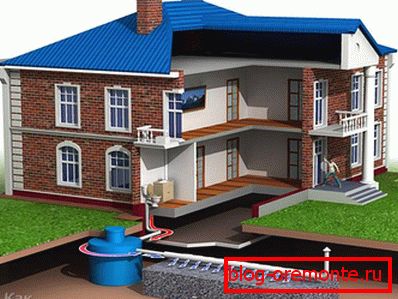
There are several basic concepts of the organization of autonomous sewage. Each manufacturer can make different variations, but the essence will remain unchanged.
- Dry closet. It will be relevant in the case when there is no need to dispose of water from baths and showers. In the process of mass processing by aerobic bacteria, substances are formed that can be used as fertilizers.
- Cesspit. This is the option when a long explanation will be inappropriate. Almost everyone who lived in a private house knows what it is. This option requires constant periodic pumping with additional means of mechanization. Here the rule was often applied - the larger the volume, the better.
- Septic tank. Эта ёмкость может быть как бетонной, так и выполненной из пластика. В первом случае применяются железобетонные кольца. Их диаметр будет зависеть от потребностей конкретной семьи. Для максимальной производительности устанавливается три колодца. Все они герметично соединены между собой при помощи труб. С пластиковыми конструкциями пользователь уже получает готовые емкости, устанавливаемые в указанной последовательности. Для септиков также важна периодическая очистка от ила, которая также производится при помощи ассенизатора.
- Mini-treatment facilities. This is a complete installation with pumps and filters, which makes it possible to process a large amount of waste in a short period of time. Suits quite large country houses.
Cesspit
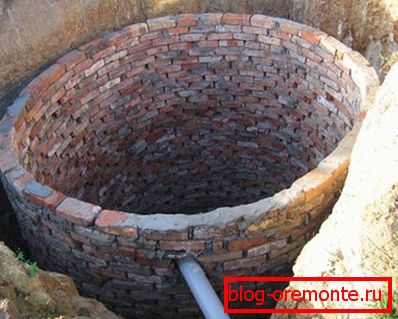 This type of sewage system has several manufacturing options:
This type of sewage system has several manufacturing options:
- Plain pit without walls. This type of pit is less effective. Over time, the fluid blurs the walls, and the entire structure may collapse.
- The walls are reinforced with tires.. The service life of such a product can reach 30 years. Obviously, holes must be made in the tires so that water can flow freely through the pores.
- With wooden supports. In this case, the walls are made of wood lining reinforced with vertical columns. If you decide to make such a construction, it will cope with its tasks for 5–7 years.
- With brick masonry. It is a fairly common option. She is able to stand for about 15 years. If it is periodically repaired, it is possible to increase this figure several times.
- Pit of concrete rings.
- With metal or plastic formwork. In these cases, an ordinary large-diameter pipe can be used, as well as a container that sinks to the required depth.
If you are going to arrange a cesspool, then it is worth weighing the strengths and weaknesses.
Positive points:
- ease of manufacture;
- relative cheapness;
- availability of materials;
- some species can be installed in close proximity to the groundwater surface.

Negative points:
- the need for frequent maintenance;
- waste disposal using a vacuum;
- the instability of building materials to the effects of wastewater;
- unpleasant smell;
- non-compliance with the standards of location leads to contamination of the site.
Next, select the type of future pit:
- Airtight. In this case, a container is installed, which is a collection for wastewater and is periodically emptied with the help of special equipment. For it it is necessary to make a concrete base and reinforce the walls to prevent damage to the tank due to the displacement of the soil.
- Open. It can be with a filtering bottom, when, before reinforcing the walls, gravel and sand filling is made to the bottom so that some of the water goes down. Also on the perimeter of the masonry walls of brick or in concrete rings are made additional holes. Over time, such a pit also needs cleaning.
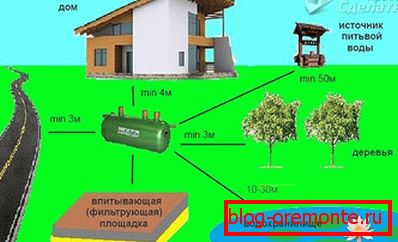
The location for the arrangement of such a construction can be chosen, guided by the instructions given above. The manufacturing process boils down to the fact that it is necessary to dig a hole of the right size and strengthen the walls with the selected material. The supply of the pipe through which the drain will occur is carried out simultaneously with the reinforcement of the walls. Do not forget to comply with technological bias. It is better if the depth of the pipe is below the freezing of the soil.
It is important to provide ventilation, which is done by withdrawing the nozzle above the surface. So gases will not accumulate, it is important that there is no fire.
Septic tank
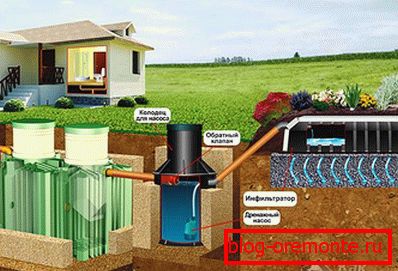
Simply put, a septic tank with sewage treatment is a few interconnected sealed cesspools. For their manufacture, you can apply the same materials as in the previous version. The principle of operation of such a device is that water that has just been drained from a house enters the first block. It accumulates, heavy inclusions settle, and partially purified water flows into the next tank. Large particles also settle there. After the second vessel, the liquid can be brought out to a special space, which is called the filtration fields, or it can get into another department for more thorough cleaning.
Since anaerobic fermentation occurs at the first stage, a sufficient amount of sludge accumulates over time. It must be removed using special equipment.

If it is decided to install not the cumulative septic tank, but the one from which the purified liquid is being withdrawn, it will be necessary to take care of the filtration fields. Before this, you need to make sure that:
- Groundwater is at a depth of more than 1.5 m.
- It is possible to remove as much as possible the filtration field from the intake of clean water (more than 30 m).
- The main layer of soil is not clay. This is important because the clay is very poor in moisture, so the efficiency of the system will tend to zero.
- Sufficient free space is available for the project.

When all the conditions are met, you can proceed to the manufacture of:
- Sewer pipes with a diameter of 110 mm are purchased.
- A trench is dug below the freezing ground level of 15? 20 cm. It should be borne in mind that at the bottom there should be a layer with good permeability.
- Next, lay a layer of sand at 10 cm and rammed.
- A layer of rubble is filled up, it should be at least 40 cm.
- Pipes are laid in the upper part of this layer.
- In order to protect them during frosts, a small backfill of rubble is placed on top and is laid geofiltered. If in your area severe frosts, then the design must be warmed.
- The next layer of the cake will be the land that will complete the construction.
- Are the corners of the pipes 90 fixed at the ends of the pipes? and vents for ventilation are displayed.
It is important to remember that self-cleaning of the soil will not last forever with constantly replenishing pollutants. Therefore, after about 7 years, you will have to make a complete replacement of the filter layer.
Installation of this type of system may require more time and effort, but its performance and efficiency is much higher than that of a conventional cesspool. In the case of septic tanks for several containers and with filtration fields, cleaning of the first stage may be required once a year or even less.
Mini-sewage treatment plant
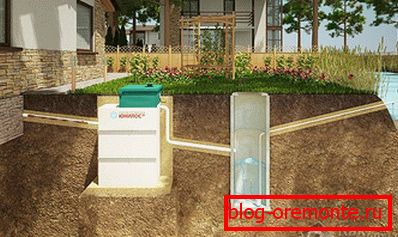
Roughly speaking, a mini-sewage treatment plant is the same septic tank, but manufactured in factory conditions. Among them are the stations:
- Anaerobic cleaning. Here, the main focus is on bacteria, with the decomposition of inclusions without oxygen.
- Aerobic cleaning. In such systems, conditions are specifically created in which the liquid is saturated with oxygen, so that bacteria can perform their tasks as quickly as possible.
- Volatile and non-volatile. In some units, pumps and electric motors are used, therefore it is necessary to supply them with an electric line.
Many consumers prefer ready-made structures, because they are easier to install, the whole mechanism is debugged and tested. Also, only in the case of such stations can water purification be achieved by 98%. This means that later it can be freely used for agricultural needs. The most popular models among consumers are:

Topaz. This is a completely finished design, made of durable plastic. In order to perform the installation, it is enough to dig a pit of a suitable size. Inside there are four cameras. In the first, large particles settle. After the water has settled, it falls into the second section, it is also called aerotank. With the help of a compressor, air is constantly supplied here, which allows bacteria to speed up processing. After that, the liquid enters the secondary settling tank, where the sludge settles and returns to the previous tank. At a certain stage, ultraviolet cleaning is also performed. Additionally, the unit can be equipped with a drainage pump, which will pump clean water into tanks or other selected place.
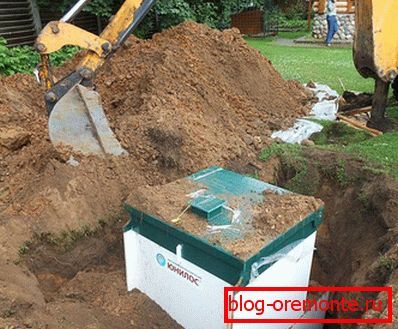
Unilos Astra. In its structure and mode of operation, it resembles the previous version. But aeration here begins to occur in the first sediment bowl. Due to this process, large particles are broken up and further drains are cleaned.
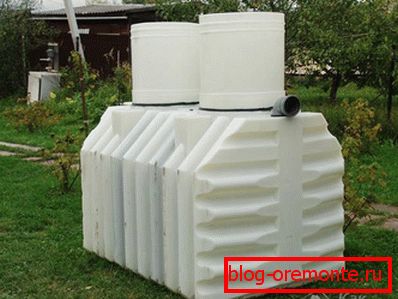
Septic tank Танк. This option does not require the supply of electrical energy. Here, all processes occur by gravity. The main camera is divided into two compartments. In the first section, the largest particles settle and splitting occurs. In the second chamber, an additional treatment is performed, then the water passes through the biofilter and is sent to the infiltrator - an additional tank that does not have a bottom. There, the liquid passes the last stages of cleaning, seeping through the filling of rubble.
If you are looking for a project to give, then perhaps you should stay at the most inexpensive option. Remember that everything can be done by hand, but this will take more time and effort.